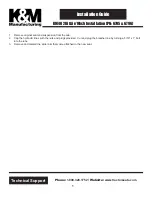
17
Care and Maintenance - Sunbrella
Woven Acrylic Fabrics
Sunbrella
woven acrylic fabrics are made of 100% solution-dyed acrylic fiber and have a special finish which
delays the formation and accumulation of dirt. To preserve this finish, cleaning of the fabric must include the
following.
Standard Maintenance
•
Thoroughly remove the dust from the dry Awning Fabric by vacuum cleaning, gently beating or brushing.
•
Then clean with a prolonged spraying of lukewarm water and a mild soap while gently brushing. Rinse
thoroughly to remove soap.
Stain Removal
For more stubborn cases, a general solution of no more than 1/2 cup (4 oz.) of bleach and 1/4 cup (2 oz.) of mild
soap per gallon of water is normally recommended. Do not leave this mixture on the Fabric for more than 20
minutes. Then the Fabric should be rinsed thoroughly with cold water to remove all of the mixture.
CAUTION: Bleach can deteriorate sewing threads. The Fabric should be rinsed thoroughly with cold water
to remove all of the soap. This method of cleaning may remove part of the water repellency of the Fabric.
Therefore, if water repellency is important, the Fabric afterwards should receive an application of any air-
curing fluorocarbon water repellent treatment, such as 303 High Tech Fabric Guard.
Applying 303 High Tech Fabric Guard
303 Should be applied to Sunbrella
woven acrylic Fabrics after each thorough cleaning, which typically
removes the original finish and reduces the Fabric’s water repellency.
• Allow the clean Fabric to completely air dry.
•
Apply 303 Fabric Guard in a well ventilated area following instructions on the container.
•
Apply 303 in a thin, even coat and allow Fabric to dry completely.
•
Apply a second thin, even coating of 303. (Two light coatings are more effective in restoring Fabric water
resistance than a single heavy coating. A 15 ounce bottle provides coverage of up to 50 square feet of
fabric).
For more information please see
www.303products.com.
CAUTION: If an Awning is retracted while wet, open it as quickly as possible and allow the Fabric to dry.
Although the Fabric is mold, mildew and rot resistant, this procedure is necessary because atmospheric
pollution deposits on the surface of the Fabric can mold and mildew under damp conditions.
















































